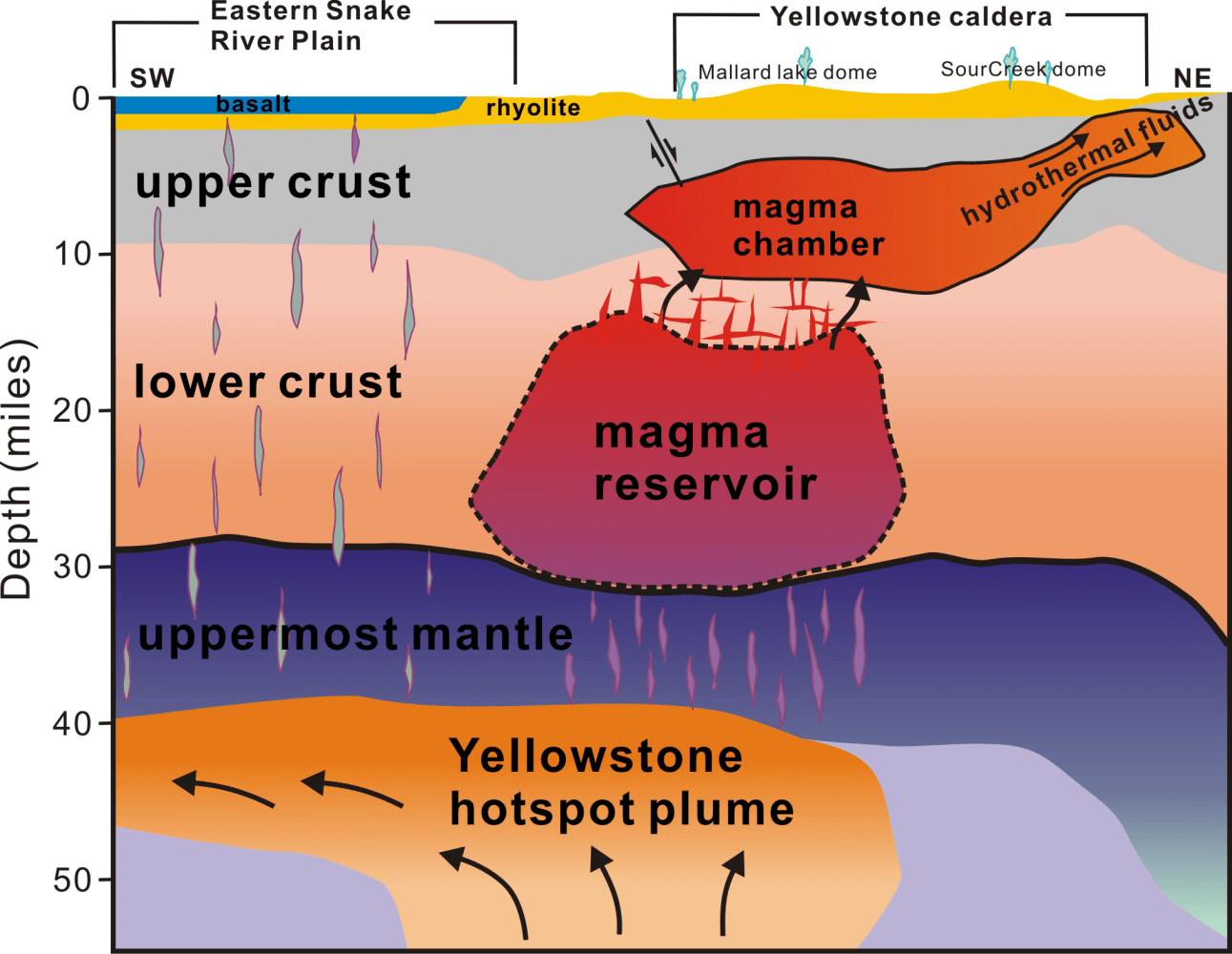Investigating Yellowstone's Magma Reservoir For Volcanic Hazard Assessment

Table of Contents
Main Points:
2.1. The Yellowstone Supervolcano: A Geological Overview
Understanding the Caldera System:
Yellowstone's caldera, a massive depression formed by past supereruptions, is a defining feature of the park. Caldera formation is a catastrophic event, resulting from the emptying of a magma chamber during a supervolcanic eruption. Yellowstone's caldera, measuring approximately 55 kilometers by 72 kilometers, is a testament to the immense power of these geological events. Its geological history spans millions of years, marked by multiple eruptions of varying intensity. The supervolcano's existence is intricately linked to the underlying North American tectonic plate and the hot spot that fuels its magma generation. Past supereruptions, like the one that created the Lava Creek Tuff 640,000 years ago, dramatically reshaped the landscape and had a significant global impact on climate and life.
- Past Supereruptions: Three supereruptions have occurred in the past 2.1 million years, leaving behind vast deposits of volcanic ash.
- Tectonic Setting: The Yellowstone hotspot, a plume of magma rising from deep within the Earth's mantle, is responsible for the ongoing volcanic activity.
- Magma Generation: The interaction between the hotspot and the overlying tectonic plate creates the conditions for magma generation and accumulation in the reservoir.
Mapping the Magma Chamber:
Mapping Yellowstone's magma chamber is a complex undertaking, relying on a combination of geophysical techniques. Seismic tomography, a method that uses seismic waves from earthquakes to create 3D images of the Earth's subsurface, plays a crucial role in imaging the magma chamber. GPS and gravity surveys provide additional data on ground deformation and subsurface density variations, further refining our understanding of the reservoir's size and shape. 3D modeling integrates this data to create detailed visualizations of the magma chamber's extent, composition, and temperature.
- Seismic Imaging: Seismic waves travel at different speeds through different materials, allowing scientists to identify the magma chamber's boundaries and internal structures.
- Geophysical Surveys: These surveys help to map the physical properties of the subsurface, providing critical information about the magma chamber's size and location.
- Challenges and Limitations: The immense depth and complexity of the magma system make complete mapping a significant scientific challenge.
2.2. Monitoring Magma Movement and Activity
Seismic Monitoring Techniques:
A dense network of seismometers constantly monitors seismic activity around Yellowstone. Earthquake swarms, characterized by frequent, relatively small earthquakes, often indicate magma movement within the reservoir. The frequency, location, and magnitude of these earthquakes are analyzed to understand the dynamics of the magma system. Sophisticated algorithms are used to interpret seismic data, providing valuable insights into magma pressure and potential changes.
- Earthquake Swarms: Increased seismic activity can signal changes in magma pressure within the reservoir.
- Seismic Data Interpretation: Analyzing the location, depth, and magnitude of earthquakes provides information about the movement of magma.
- Limitations: Not all seismic activity is directly related to magma movement; some events may be due to other tectonic processes.
Ground Deformation Measurement:
GPS and InSAR (Interferometric Synthetic Aperture Radar) are used to measure subtle changes in the Earth's surface. Ground uplift, caused by increased magma pressure, and subsidence, reflecting magma withdrawal, are carefully monitored. These measurements are crucial for detecting changes in the magma reservoir's pressure and volume, providing early warnings of potential volcanic activity.
- GPS Monitoring: Continuous GPS measurements reveal subtle changes in ground elevation, providing insights into magma movement.
- InSAR: InSAR uses satellite radar data to detect even smaller ground deformation signals than GPS.
- Predictive Potential: These techniques are valuable tools for predicting potential eruptions, although uncertainties remain.
Gas Emissions Monitoring:
Monitoring gas emissions, such as carbon dioxide (CO2), sulfur dioxide (SO2), and helium (He), provides additional indicators of magma activity. Increased gas flux often accompanies magma movement toward the surface. Gas geochemistry analyses help to determine the source and composition of the gases, providing valuable insights into the underlying volcanic processes.
- CO2 Emissions: Increased CO2 emissions can indicate a rise in magma pressure.
- SO2 Flux: SO2 is a direct indicator of magmatic degassing and can signify increased volcanic unrest.
- Hazard Assessment: Gas monitoring is a valuable tool for assessing the level of volcanic hazard.
2.3. Assessing Volcanic Hazards and Risk Mitigation
Probabilistic Volcanic Hazard Assessment:
Scientists utilize probabilistic volcanic hazard assessment to estimate the likelihood of future eruptions of various magnitudes. This involves analyzing historical data, geological models, and statistical methods to generate eruption scenarios and their associated probabilities. This provides a framework for understanding the potential risks associated with Yellowstone's Magma Reservoir.
- Historical Data Analysis: Studying past eruptions provides crucial insights into the recurrence intervals and magnitudes of future events.
- Geological Models: Models help simulate the physical processes involved in volcanic eruptions and assess their potential impacts.
- Uncertainty: Predicting volcanic eruptions remains a challenging task, with inherent uncertainties.
Developing Mitigation Strategies:
Mitigating volcanic hazards requires a multi-pronged approach. Evacuation plans are crucial for ensuring public safety in case of an eruption. Early warning systems, leveraging the data from monitoring techniques, are essential for providing timely alerts. Public awareness and education initiatives play a critical role in community preparedness. Government agencies and scientific organizations work together to develop and implement comprehensive hazard management strategies.
- Evacuation Planning: Clear and well-rehearsed evacuation plans are essential for minimizing casualties.
- Early Warning Systems: Real-time monitoring data allows for early warning of potential eruptive activity.
- Community Preparedness: Public awareness programs educate communities about volcanic hazards and response procedures.
Conclusion: Understanding and Managing the Risks of Yellowstone's Magma Reservoir
Yellowstone's Magma Reservoir represents a powerful and dynamic geological system. Ongoing monitoring and research are essential for understanding its behavior and assessing the associated volcanic hazards. While predicting eruptions with certainty is challenging, the techniques described in this article provide crucial insights into the reservoir's activity and its potential for future eruptions. Effective mitigation strategies, encompassing early warning systems, evacuation plans, and public education, are vital for minimizing the impacts of future volcanic events. We must continue to invest in research and monitoring of Yellowstone's Magma Reservoir to ensure the safety and well-being of the surrounding communities. Learn more about the ongoing research efforts related to Yellowstone's Magma Reservoir and its potential for future eruptions by exploring resources from the USGS and Yellowstone National Park. Understanding this unique geological feature is key to responsible stewardship and preparedness.

Featured Posts
-
 A Trump Kormanyzat Kepviselojenek Talalkozoja Putyinnal
May 27, 2025
A Trump Kormanyzat Kepviselojenek Talalkozoja Putyinnal
May 27, 2025 -
 Coupe De La Caf Programme Des Matchs Berkane Constantine
May 27, 2025
Coupe De La Caf Programme Des Matchs Berkane Constantine
May 27, 2025 -
 Demenagement Des Maternelles A Saint Ouen Fermeture Pour Trafic De Drogues
May 27, 2025
Demenagement Des Maternelles A Saint Ouen Fermeture Pour Trafic De Drogues
May 27, 2025 -
 Yellowstone Spinoff John Dutton Iiis Continued Role Without Kevin Costner
May 27, 2025
Yellowstone Spinoff John Dutton Iiis Continued Role Without Kevin Costner
May 27, 2025 -
 Tokyo To Seattle Flight Diverted Due To Passenger Incident
May 27, 2025
Tokyo To Seattle Flight Diverted Due To Passenger Incident
May 27, 2025
Latest Posts
-
 Elon Musks Daughters New Career A Closer Look
May 30, 2025
Elon Musks Daughters New Career A Closer Look
May 30, 2025 -
 From Silicon Valley To Runway Vivian Musks Journey
May 30, 2025
From Silicon Valley To Runway Vivian Musks Journey
May 30, 2025 -
 Analysis Of Vivian Jenna Wilsons Modeling Debut And Family Life
May 30, 2025
Analysis Of Vivian Jenna Wilsons Modeling Debut And Family Life
May 30, 2025 -
 A Public Feud Bill Gates Serious Allegations Against Elon Musk And The Response
May 30, 2025
A Public Feud Bill Gates Serious Allegations Against Elon Musk And The Response
May 30, 2025 -
 The Musk Gates Dispute Accusations Of Negligence And Child Mortality
May 30, 2025
The Musk Gates Dispute Accusations Of Negligence And Child Mortality
May 30, 2025
